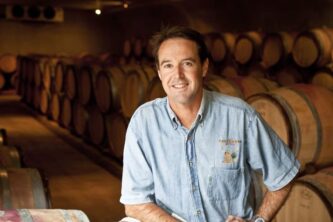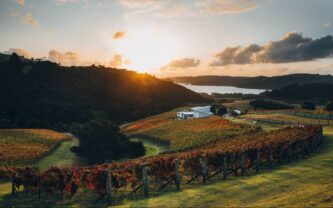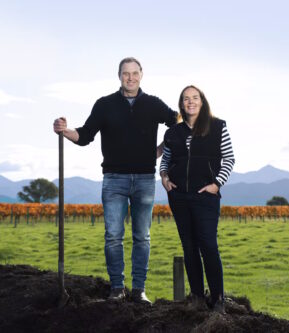Stephanie Holmes, Editor – Lifestyle Brands NZ Herald | May, 2025
Expert judges have crowned the top 50 wineries for 2025, with a Central Otago winery taking the top spot for the second year running.
Online wine critic platform The Real Review has named Bannockburn’s Felton Road as Winery of the Year.
“In a competitive field, Felton Road continues to lead by example,” says judge Stephen Wong, MW.
“Their wines are defined by purity, balance and a deep respect for the land.”
Wong says the second consecutive win reflects the winery’s “continuous improvement” that “sets a benchmark for the industry”.
The annual top wineries list recognises excellence across the country.
Wong says Kiwi wine-drinkers can use the list to give them “a clear sense of who is leading the way in New Zealand winemaking right now”.
Waiheke’s Destiny Bay took the runner-up spot this year, with Te Whare Rā and Framingham (both from Marlborough) and Martinborough’s Dry River rounding out the top five.
This year’s awards introduced a new “Best in Class” category, celebrating excellence across various wine styles. The inaugural winners were Quartz Reef‘s Methode Traditionnelle Blanc de Blancs 2017 for Sparkling Wine of the Year; Prophet’s Rock Cuvée Aux Antipodes Blanc 2022 for White Wine of the Year; Doctors Flat Pinot Noir 2021 for Red Wine of the Year; and Astrolabe’s Wrekin Vineyard Late Harvest Chenin Blanc 2022 for Sweet Wine of the Year.
It is also the first time a Vigneron of the Year award has been presented, recognising excellence in viticulture.
Anna and Jason Flowerday of Marlborough’s certified organic winery, Te Whare Rā, are the inaugural winners.
“Highlighting individual wines and the people behind them allows us to tell a fuller story of New Zealand wine’s journey,” says Wong.
“As our industry matures, it’s vital we recognise not just the wines, but the people and philosophies shaping them.”
Wong says the Flowerdays were recognised because of their “deep connection between vineyard and bottle”, praising their commitment to sustainability while retaining a commitment to striving for excellence.
Rounding out the awards, Simon Sharpe and Lauren Keenan of Marlborough winery A Thousand Gods were awarded the Rising Star of the Year.
Enthusiasts can sample 80 of this year’s award-winning wines and meet the winemakers at a tasting event in Auckland on June 7, with tickets available via The Real Review’s website.
NZ wineries will be further recognised in August, with Viva’s own Top 50 wine awards, judged by Viva Wine Editor Dr Jo Burzynska.
The full 2024 list of winners can be found at viva.co.nz.
See the Real Review’s Top 50 Wineries of New Zealand 2025 below:
1. Felton Road – Bannockburn, Central Otago
2. Destiny Bay – Waiheke Island, Auckland
3. Te Whare Rā Wines – Renwick, Marlborough
4. Framingham – Renwick, Marlborough
5. Dry River Wines – Martinborough, Wairarapa
6. Prophet’s Rock – Bendigo, Central Otago
7. Te Mata Estate – Havelock North, Hawke’s Bay
8. Rippon – Wanaka, Central Otago
9. Ata Rangi – Martinborough, Wairarapa
10. Pyramid Valley Vineyards – Waikari, North Canterbury
11. Craggy Range – Havelock North, Hawke’s Bay
12. Bell Hill – Waikari, North Canterbury
13. Obsidian – Waiheke Island, Auckland
14. Hans Herzog Estate – Rapaura, Marlborough
15. Kusuda Wines – Martinborough, Wairarapa
16. Church Road – Napier, Hawke’s Bay
17. Rockburn Wines – Cromwell, Central Otago
18. Elephant Hill Estate – Te Awanga, Hawke’s Bay
19. Villa Maria – Auckland
20. Smith & Sheth – Havelock North, Hawke’s Bay
21. Cloudy Bay – Blenheim, Marlborough
22. Fromm Winery – Blenheim, Marlborough
23. Bilancia – Hawke’s Bay
24. Neudorf – Upper Moutere, Nelson
25. Gibbston Valley Wines – Gibbston, Central Otago
26. Wild Irishman – Gibbston, Central Otago
27. Siren Wine – Marlborough
28. Corofin – Blenheim, Marlborough
29. Terra Sancta – Bannockburn, Central Otago
30. Blank Canvas – Marlborough
31. A Thousand Gods – Marlborough
32. Tantalus Estate – Waiheke Island, Auckland
33. Mt Difficulty Wines – Bannockburn, Central Otago
34. Puriri Hills – Clevedon, Auckland
35. Greystone Wines – Waipara, North Canterbury
36. Black Estate – North Canterbury
37. Charteris – Central Otago
38. Radburnd Cellars – Hawke’s Bay
39. Doctors Flat – Central Otago
40. Isabel Estate – Marlborough
41. Dog Point Vineyard – Marlborough
42. Batch Winery – Waiheke Island, Auckland
43. Giesen Wine Estate – Marlborough
44. Forager Wine – Marlborough
45. Valli – Central Otago
46. Man O’ War Vineyards – Waiheke Island, Auckland
47. Astrolabe Wines – Marlborough
48. Mudbrick – Waiheke Island, Auckland
49. Clos Henri – Marlborough
50. The Boneline – North Canterbury




















